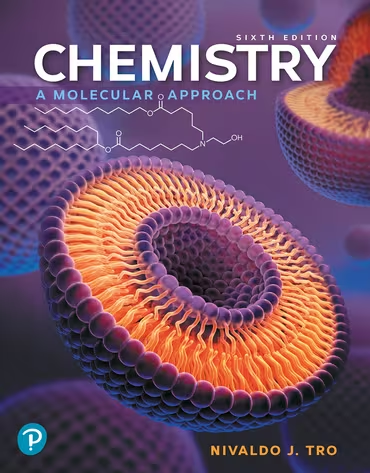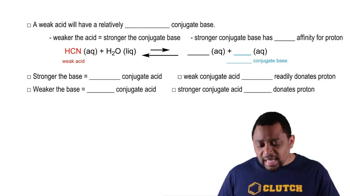For each solution, calculate the initial and final pH after adding 0.010 mol of NaOH. a. 250.0 mL of pure water b. 250.0 mL of a buffer solution that is 0.195 M in HCHO2 and 0.275 M in KCHO2 c. 250.0 mL of a buffer solution that is 0.255 M in CH3CH2NH2 and 0.235 M in CH3CH2NH3Cl
Ch.18 - Aqueous Ionic Equilibrium

Chapter 18, Problem 54d
Determine whether or not the mixing of each pair of solutions results in a buffer. d. 105.0 mL of 0.12 M CH3NH2 ; 110.0 mL of 0.15 M CH3NH3Cl
 Verified step by step guidance
Verified step by step guidance1
Identify the components of the solutions: CH3NH2 is a weak base and CH3NH3Cl is its conjugate acid.
Calculate the moles of CH3NH2: Use the formula \( \text{moles} = \text{volume (L)} \times \text{molarity (M)} \).
Calculate the moles of CH3NH3Cl: Use the same formula \( \text{moles} = \text{volume (L)} \times \text{molarity (M)} \).
Determine if the solution can act as a buffer: A buffer solution contains a weak acid and its conjugate base or a weak base and its conjugate acid in comparable amounts.
Compare the moles of CH3NH2 and CH3NH3Cl to see if they are present in significant amounts to resist changes in pH.

Verified video answer for a similar problem:
This video solution was recommended by our tutors as helpful for the problem above.
Video duration:
6mWas this helpful?
Key Concepts
Here are the essential concepts you must grasp in order to answer the question correctly.
Buffer Solutions
A buffer solution is a system that resists changes in pH upon the addition of small amounts of acid or base. It typically consists of a weak acid and its conjugate base or a weak base and its conjugate acid. In this case, the presence of CH3NH2 (a weak base) and CH3NH3Cl (its conjugate acid) suggests that the mixture could function as a buffer.
Recommended video:
Guided course

Buffer Solutions
Weak Bases and Conjugate Acids
Weak bases are substances that partially ionize in solution, establishing an equilibrium between the base and its conjugate acid. CH3NH2 is a weak base, and when mixed with CH3NH3Cl, it can establish an equilibrium that allows the solution to maintain a relatively stable pH, characteristic of buffer systems.
Recommended video:
Guided course

Conjugate Acid-Base Relationships
Henderson-Hasselbalch Equation
The Henderson-Hasselbalch equation is used to calculate the pH of a buffer solution. It relates the pH to the pKa of the weak acid and the ratio of the concentrations of the conjugate base and acid. This equation is essential for determining the effectiveness of the buffer formed by the mixing of CH3NH2 and CH3NH3Cl.
Recommended video:
Guided course

Henderson-Hasselbalch Equation
Related Practice
Textbook Question
Textbook Question
A 100.0-mL buffer solution is 0.100 M in NH3 and 0.125 M in NH4Br. What mass of HCl can this buffer neutralize before the pH falls below 9.00?
2
views
Textbook Question
Determine whether or not the mixing of each pair of solutions results in a buffer. b. 125.0 mL of 0.14 M HF; 195.0 mL of 0.070 M NaOH
1
views
Textbook Question
Determine whether or not the mixing of each pair of solutions results in a buffer. c. 55.0 mL of 0.15 M HF; 85.0 mL of 0.10 M NaF
1
views
Textbook Question
Determine whether or not the mixing of each pair of solutions results in a buffer. a. 155.0 mL of 0.15 M NH3 ; 175.0 mL of 0.17 M HCl
1
views
